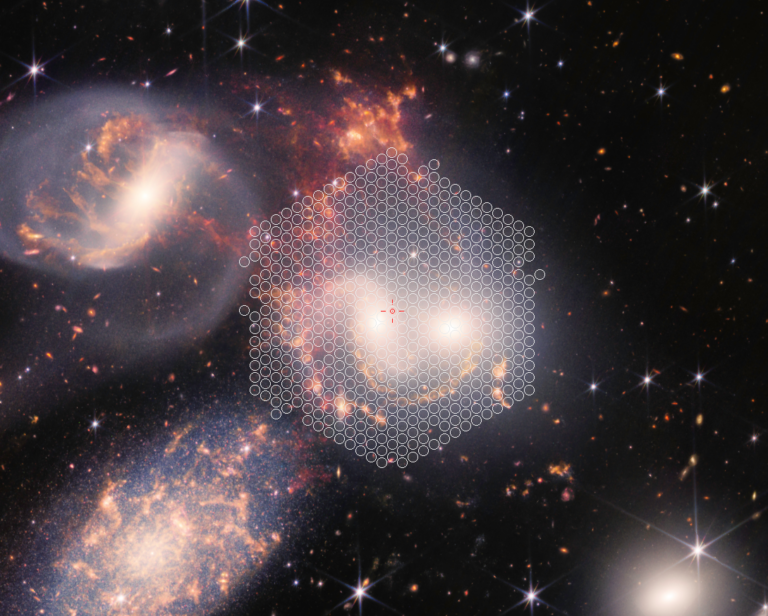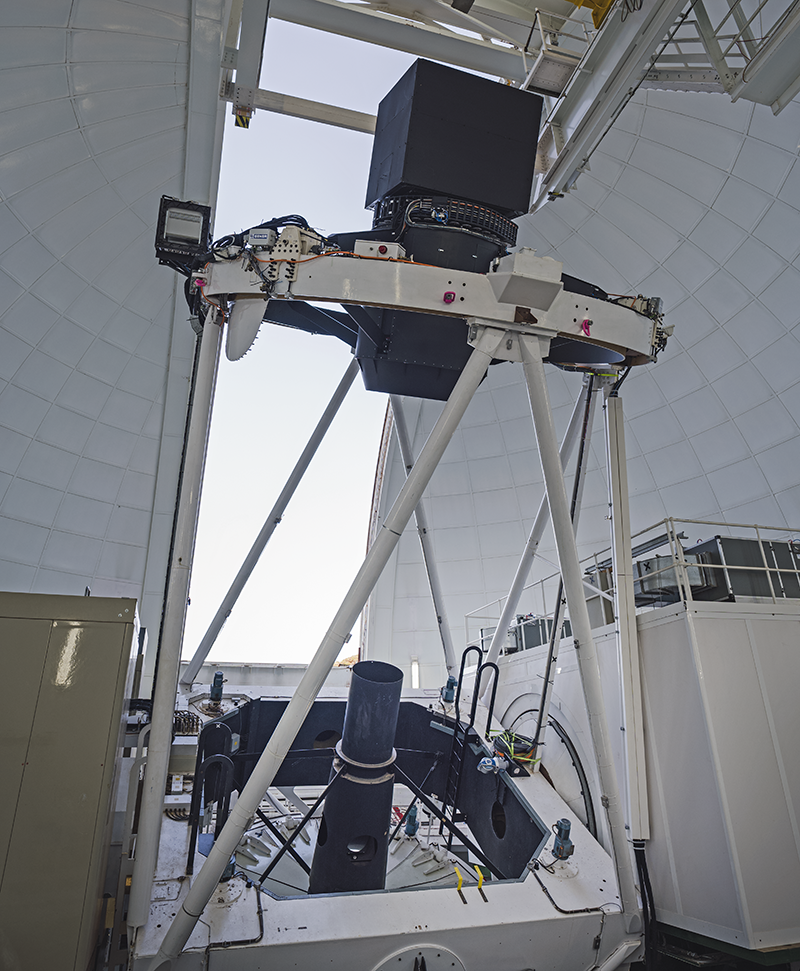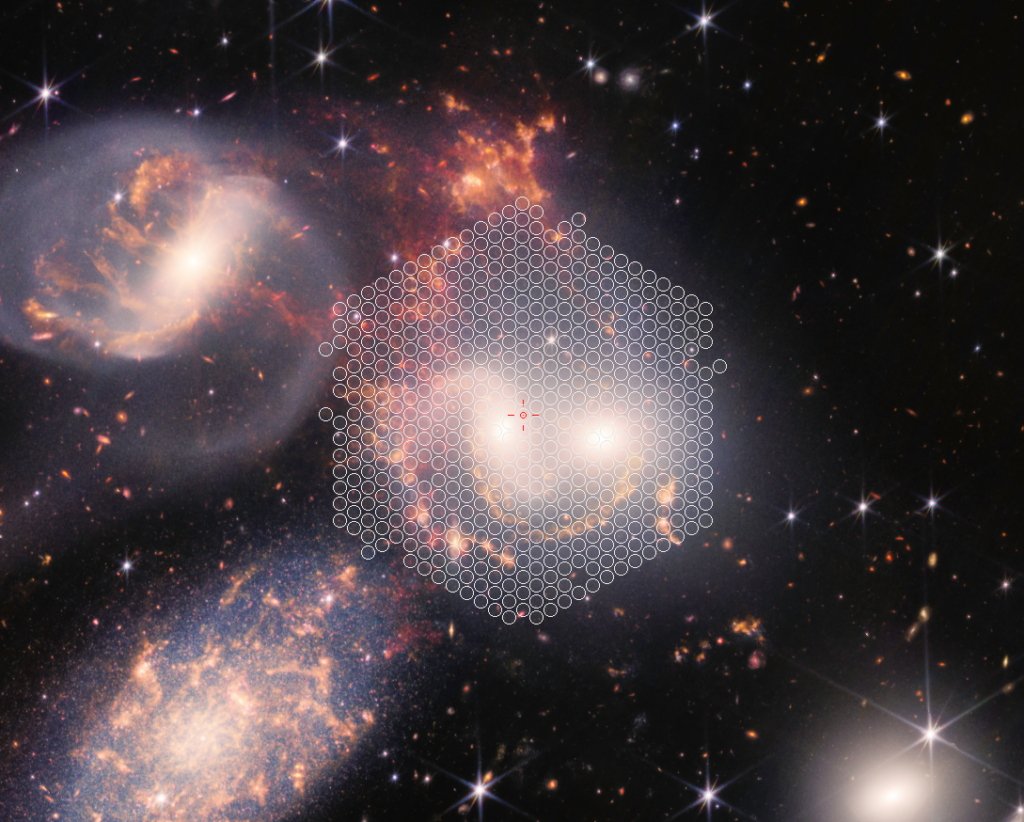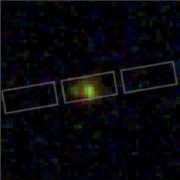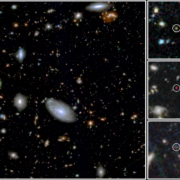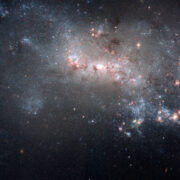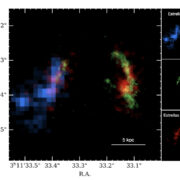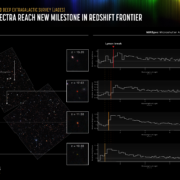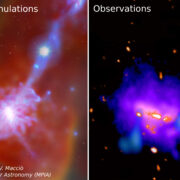WEAVE First Light
The Isaac Newton Group of Telescopes (ING) and the WEAVE instrument team present first-light observations with the WEAVE spectrograph. WEAVE is a powerful, next-generation multi-fibre spectrograph on the William Herschel Telescope (WHT) at the Observatorio del Roque de los Muchachos (La Palma, Canary Islands) now being commissioned on-sky and already generating high-quality data.
First-light observations were carried out with the fibre bundle named large integral-field unit (LIFU), one of WEAVE’s three fibre systems. When using the LIFU, 547 closely packed optical fibres transmit the light in a hexagonal area of the sky to the spectrograph, where it is analysed and recorded.
The LIFU was aimed at NGC 7318a and NGC 7318b, two galaxies at the heart of Stephan’s Quintet, a group of interacting galaxies. It’s been observed with Hubble, Spitzer, Chandra and other telescopes, and recently by JWST. It’s also famous for its cinematic role in the 1946 Christmas film It’s a Wonderful Life (whose director, Frank Capra, had a chemical engineering degree from Caltech). The group, 280 million light-years from Earth in the constellation Pegasus, is undergoing a major galaxy collision and provides a natural laboratory for the consequences of galaxy collisions on the evolution of galaxies.
Marc Balcells, ING Director, explains: «Our goal was to host a unique instrument that would allow astronomers to carry out cutting-edge astronomical research. It’s been fantastic to receive generous financial support from the national research agencies in the three partner countries, as well as contributions from non-ING countries. We are now happy to show that the LIFU part of WEAVE not only works, but produces high-quality data. The ING telescopes will continue to provide results of high scientific impact for years to come. We expect soon to announce subsequent first-light events for the other observing modes, now undergoing their own final tuning and calibration.»
About the First-Light Observations
The WEAVE LIFU measures separate spectra for 547 different regions of the two galaxies and their vicinity, recording the colours of their light from the ultraviolet to the near-infrared. These spectra reveal the motions of stars and gas, the chemical composition of the stars, the temperatures and densities of the gas clouds, and more. From these data, astronomers can learn how galaxy collisions transform the galaxies in the group.
Gavin Dalton, WEAVE’s Principal Investigator said that «the wealth of complexity revealed in this way by a single detailed observation of this pair of nearby galaxies provides insights into the interpretation of the many millions of spectra that WEAVE will obtain from galaxies in the distant Universe and provides an excellent illustration of the power and flexibility of the WEAVE facility.» On the same line, Scott Trager, WEAVE’s Project Scientist, commented that «these observations show the power of WEAVE to unravel the complex phenomena involved in the evolution of galaxies throughout the history of the Universe. The more than 500 members of the WEAVE Science Team and the members of the wider ING community will certainly make great discoveries with WEAVE’s exciting new capabilities.»

Who Will Use WEAVE
In the coming five years the ING will assign 70% of the time available on the WHT to eight major surveys with WEAVE, selected out of those proposed by the astronomical communities of the partner countries. All these surveys require spectra of up to millions of individual stars and galaxies, a goal now obtainable thanks to WEAVE’s ability to observe almost 1000 objects at a time.
The ING will also make 30% of the time available for projects selected competitively from those proposed by astronomers in the ING partner countries. These projects will leverage WEAVE’s versatility to provide fast responses to immediate questions. There are also channels for programmes that jointly exploit WEAVE and the diverse capabilities of the telescopes in the Canarian Observatories such as the 10.4-metre Gran Telescopio Canarias.
WEAVE-StePS and WEAVE-SCIP
Over 500 astronomers from across Europe have organized eight major surveys using WEAVE, covering studies of stellar evolution, Milky Way science, galaxy evolution, and cosmology.
WEAVE-Stellar Populations at intermediate redshift Survey (WEAVE-StePS in short; PI: Angela Iovino) is one of the eight surveys that the WEAVE spectrograph will perform, using a total of approximately 1150 nights over five years of WHT time. Luca Costantin, member of the WEAVE-StePS survey and research fellow at the Centro de Astrobiología in Madrid, explained that “thanks to WEAVE, the StePS collaboration will soon collect spectra of more than 25,000 galaxies, which will allow studying with unprecedented details the properties of the Universe in the last 7 billion years.”
Another one of the surveys is WEAVE-SCIP (Stellar, Circumstellar, and Interstellar Physics; PI: Janet Drew). It will cover the northern Galactic Plane and will study OBA stars, ionized nebulae, young stars, white dwarfs, and compact binaries. Jesús Maíz Apellániz, a senior researcher at the Centro de Astrobiología and member of the WEAVE-SCIP team, indicates that “WEAVE-SCIP is a unique opportunity to follow up on the steps of the Gaia ESA mission, which has revolutionized Galactic science by providing accurate astrometry and photometry for over a billion stars. WEAVE-SCIP will allow us to obtain spectroscopy for objects identified by Gaia or for which Gaia was not optimized, such as massive O stars.”
More Information
The official ING press release is available at this link.
Scientific paper to be published in MNRAS.
Reference: Jin, Trager, Dalton et al. 2022, in press (arXiv:2212.03981)
Contact: lcostantin@cab.inta-csic.es, jmaiz@cab.inta-csic.es
CAB researchers: Luca Costantin, Jesús Maiz Apellániz






